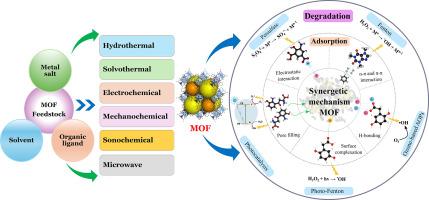Pharmaceutical removal from aquatic environments using multifunctional metal-organic frameworks (MOFs) materials for adsorption and degradation processes: a review
IF 23.5
1区 化学
Q1 CHEMISTRY, INORGANIC & NUCLEAR
引用次数: 0
Abstract
Pharmaceutical residues in water pose a significant environmental and public health challenge, mainly originating from urbanization, hospital effluents, and pharmaceutical manufacturing. Effective remediation is crucial before their discharge into aquatic systems. Traditional wastewater treatment often fails to remove these contaminants effectively. Adsorption is efficient but merely transfers pollutants between phases, requiring further treatment. While advanced oxidation processes (AOPs) enable degradation, they typically exhibit low mineralization efficiency and limited effectiveness at low pollutant concentrations. Combining adsorption with degradation addresses key challenges by enabling the degradation of adsorbed pollutants into harmless byproducts while regenerating the catalyst for reuse. Developing dual-function catalysts is crucial for commercial applications. Metal-organic frameworks (MOFs) are promising due to their high surface area, porosity, stability, and abundant functional groups. While most studies focus on MOFs for single catalytic applications, their dual role as adsorbents and AOP activators remains underexplored. This review highlights advancements in MOF synthesis, modification, and application for pharmaceutical removal from water. MOFs with high adsorption capacity and catalytic activity in AOPs have demonstrated significant potential for pharmaceutical wastewater treatment, offering dual benefits in water purification. This review covers recent research progress, sustainable MOF design strategies, limitations, mechanisms, and future directions, with a focus on the potential for large-scale applications in pharmaceutical wastewater treatment. This review is a valuable resource for researchers studying MOF-based adsorption and catalytic degradation for pharmaceutical wastewater remediation.


多功能金属有机框架(mof)材料在水生环境中吸附和降解过程中的药物去除研究进展
水中的药物残留对环境和公共卫生构成重大挑战,主要来自城市化、医院废水和制药生产。在它们排放到水生系统之前,有效的修复是至关重要的。传统的废水处理往往不能有效地去除这些污染物。吸附是有效的,但只是在阶段之间转移污染物,需要进一步处理。虽然高级氧化过程(AOPs)能够降解,但它们通常表现出低矿化效率和低污染物浓度下的有限效果。将吸附与降解相结合,可以将吸附的污染物降解为无害的副产品,同时再生催化剂以供重复使用,从而解决了关键问题。开发双功能催化剂对商业应用至关重要。金属有机骨架(mof)具有高表面积、高孔隙率、高稳定性和丰富的官能团等优点,具有广阔的应用前景。虽然大多数研究都集中在mof的单一催化应用上,但它们作为吸附剂和AOP活化剂的双重作用仍未得到充分探索。本文综述了MOF的合成、改性及其在水中脱除药物方面的应用进展。mof在AOPs中具有较高的吸附能力和催化活性,在制药废水处理中具有巨大的潜力,在水净化方面具有双重效益。本文综述了近年来的研究进展、可持续MOF设计策略、局限性、机制和未来发展方向,重点介绍了MOF在制药废水处理中的大规模应用潜力。本文综述为mof基吸附和催化降解在制药废水修复中的应用研究提供了宝贵的参考资料。
本文章由计算机程序翻译,如有差异,请以英文原文为准。
求助全文
约1分钟内获得全文
求助全文
来源期刊

Coordination Chemistry Reviews
化学-无机化学与核化学
CiteScore
34.30
自引率
5.30%
发文量
457
审稿时长
54 days
期刊介绍:
Coordination Chemistry Reviews offers rapid publication of review articles on current and significant topics in coordination chemistry, encompassing organometallic, supramolecular, theoretical, and bioinorganic chemistry. It also covers catalysis, materials chemistry, and metal-organic frameworks from a coordination chemistry perspective. Reviews summarize recent developments or discuss specific techniques, welcoming contributions from both established and emerging researchers.
The journal releases special issues on timely subjects, including those featuring contributions from specific regions or conferences. Occasional full-length book articles are also featured. Additionally, special volumes cover annual reviews of main group chemistry, transition metal group chemistry, and organometallic chemistry. These comprehensive reviews are vital resources for those engaged in coordination chemistry, further establishing Coordination Chemistry Reviews as a hub for insightful surveys in inorganic and physical inorganic chemistry.
 求助内容:
求助内容: 应助结果提醒方式:
应助结果提醒方式:


